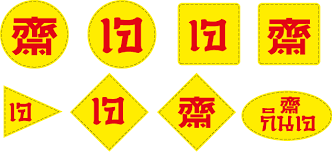People often wonder how I could possibly ever survive here in Thailand as a vegan. Considering I’ve been here well over 10 years and I still haven’t died, I think I’m doing fairly well. There is veggie food all around you, and I’m not just talking the salad shops that have sprung up in the last 2 years or. There are tons of veggie spots in town. On Suthep road alone, there are 3 lined up in a row each doing their own thing and there are 3 more down back roads within 5 minute walking distance from the first 3.
There are 2 main types of vegetarian/vegan eats in Thailand and while they both avoid meat entirely, there are a some important differences.
เจ (jeh) Vegan versus มังสวิรัติ (Mangsawira) Vegetarian
มังสวิรัติ [mang sa wi rut] comes from the Sanskrit mamsa, which means “meat” and virat which means “without.” So this is essentially an acceptable translation of “vegetarian.” As with in English, some people may or may not eat eggs and/or dairy.
เจ [jeh] comes from the Chinese word 齋 (jai1/jaai1) which is also the source for the equivalent words in Korean, Japanese, and Vietnamese.
If you happen to be reading this in October, then you are in luck, my friend. This is when the Vegetarian Festival (เทศกาลกินเจ) happens. During that time almost everybody gets on the jeh train for a bit. Some people eat jeh for the entire month, the entire 10 day festival, and most franchise restaurants (Black Canyon, MK, etc) offer at least one jeh option, but some actually have a full jeh menu during the festival. The only downside is that a lot of regular jeh restaurants don’t really do anything special during this time except get a lot more crowded than usual and in some cases raise their prices. Yay for jeh.
As far as the food goes, the main difference between Jeh and Mung is that real Jeh forbids eating food with really strong flavours and/or smells as it is believed that each one does harm to different parts of the body. This includes stuff like chives, garlic, parsley, and onions.
So what does all this mean for you? Real Jeh food will always be vegan. But, you need to be careful as some jeh places will have 1 or 2 Mung options which may contain egg. And even though jeh avoids really strong flavours, it can still taste pretty awesome. They often make all kinds of fake vegan meats to help ease the suffering of all those poor meat eaters who torture themselves by abstaining from me for a meal, a day or the entire vegetarian festival.
What are my choices?
- Jeh – Technically vegan, but watch out for those handful of places that will have one or 2 dishes with egg. Jeh spots will almost always have one or more yellow flags posted both inside and out. The flag will either say เจ, the Chinese character the word is based on or both. They often use a Chinese-y font so sometimes the word เจ looks a bit like the number “17”.
- Mung(sawirat) – Vegetarian w/eggs. As far as things eaten with rice, dairy is pretty rare, but pastries and other sweets sold at Mung places may contain butter, cream and/or milk.
What do I do if I can’t find a jeh place?
Some regular restaurants may attempt to accommodate you or at least make you think they are doing so.
How to Avoid Eating Animal Products in Thailand:
More than anything else, you’ll want to watch out for oyster sauce. Vegetable dishes at regular restaurants will almost always be cooked with oyster sauce. Oyster sauce is dark, oily and gummy. And it comes from oysters! If you don’t want it in there, you gotta say so. You’ll know if it’s not in there, because they will probably only have used soy sauce and vegetable oil. So it may be bland, but vegan.
Solution: ไม่ ใส่ น้ำ-มัน-หอย (mai sai nam-man-hoi) – Don’t put in oyster sauce.
Fish sauce is another standard ingredient in a lot of (almost all!) Thai dishes.
Solution: ไม่ ใส่ น้ำ-ปลา (mai sai nam-plaa)
Soup broth – At non-jeh places, even if they say there isn’t any meat in it, it will still have meat stock so skip the soup.
Thai Dishes that usually Contain Egg:
- ข้าวผัด – fried rice (khaao pad)
- ผัดไทย – pad thai
- ผัดซีอิ๊ว – pad see-yu
Notice the word ผัด (pad) appears in all 3 of the words above. ผัด = stir-fried/sauteed
How to say “Don’t put egg in”
ไม่ ใส่ ไข่ (mai sai kai) = don’t put in egg
Even if you ask for something jeh, they don’t always really know what that means so you are better off making it as clear as possible.
Full Sentence: เอา ข้าวผัด เจ ไม่ใส่ไข่ (ow kaaw pad jeh mai sai kai) – I’d like fried rice (jeh) without egg.
First thing you want to do is find out if they are willing to try to make you something jeh/mung. And just because they tell you they can, doesn’t mean they aren’t going to forget and give you something wish oyster sauce or fish sauce. Aside from being a tonal language, Thai also contains a whole lot more vowel sounds than English and when you say the vowels wrong, people probably won’t understand you. Be patient with them as you are the one who needs something from them and may not be able to
speak their language.
I remember this one time, a buddy of mine ordered a bottle of water and got a coconut, so watch out friends, watch out.


